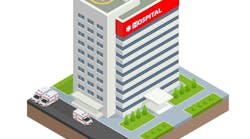Studies have shown the use of interactive teaching methods in the classroom can significantly increase learning and retention. The use of these technologies can help overcome many challenges previously noted by helping engage students in an otherwise one-way teaching environment. Two current classroom technologies that can dramatically impact overcoming classroom challenges and improve student retention are the use of interactive whiteboards and student response systems.
Interactive whiteboards
An interactive whiteboard is a device that interprets a projected image and interacts with a computer’s desktop. A computer is normally controlled by a mouse. The interactive whiteboard allows control to take place with your finger or with (electronic) pens directly on the board. Now the instructor can control all the computer actions from the front of the classroom. The writing or drawing performed on the board, such as installation diagrams or session notes, can be saved and then printed or e-mailed. Some of these boards even have software called Optical Character Recognition (OCR) meaning you can write on the screen and it will be converted to plain text.
In addition, interactive whiteboards allow instructors to record their instruction and post the material for review by students at a later time. This can be effective for students who were not able to attend the training session, need to see the material presented again or need to review for certification examinations.
Student Response Systems
Student Response Systems, also called Classroom Communication Systems (CCS), is a combination of software and hardware designed to support communication and interactivity in the classroom. A student response system is technology that:
- Allows an instructor to present a question or problem to the class
- Allows students to enter their answers into a wireless device
- Instantly summarizes students’ answers for the instructor
A Student Response System can be used to insert occasional audience questions into an otherwise traditional lecture, to quiz students for comprehension, or simply to keep students awake.
Instruction utilizing Student Response Systems makes students active participants in the learning process, thereby making students eager to participate in the class questions and surveys. This results in more retention than the traditional lecture format. Subject reviews assure the material is being retained and automatic scoring reduces the trainer’s workload.
The challenges
One barrier to implementing new technologies in the classroom is the cost of the new product. While the cost for these new technologies has come down significantly over the years, there is still an expense to consider. However, one of the most significant barriers to any new technology adoption is the fact that instructors must learn new skills and adjust to new roles. The instructor must master the skills to use the new technology selected (pen, tablet, whiteboard, clicker, software, etc.) and must feel comfortable using the system in front of the students. They must also learn to plan their curriculum around the new technology, rather than teaching as they have always done.
While some of these challenges may seem significant, changing the way we teach and improving our classroom settings will have immeasurable benefits for both the students and the instructors who are teaching them. As instructors we are accustomed to being the focus of attention in the classroom. To implement these new tools effectively, we must learn to give up control and allow learning to occur around us and not at us.
Connie Moorhead is the President of The CMOOR Group and founder of SecurityCEU.com, Louisville, KY.

